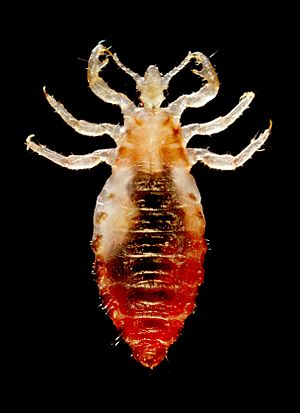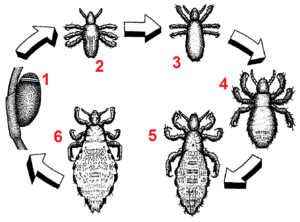Body louse facts for kids
Quick facts for kids Body louse |
|
|---|---|
 |
|
| Scientific classification |
|
| Kingdom: | Animalia |
| Phylum: | Arthropoda |
| Class: | Insecta |
| Order: | Phthiraptera |
| Family: | Pediculidae |
| Genus: | Pediculus |
| Species: |
P. humanus
|
| Subspecies: |
P. h. humanus
|
| Trinomial name | |
| Pediculus humanus humanus Linnaeus, 1758
|
|
A body louse (Pediculus humanus humanus) is a tiny insect that lives on humans. It is a type of louse that feeds on blood. Body lice are different from head lice and crab lice, which are the other two types of lice that live on people.
Even though they are called "body lice," these tiny creatures do not live directly on your skin. Instead, they usually live on the fibers of your clothes. They only come onto your skin when they need to feed on blood. Body lice cannot jump or fly. They spread from person to person through direct contact. Sometimes, they can also spread through shared clothing or bedding that has lice on it.
Body lice can carry germs that cause diseases. These diseases include epidemic typhus, trench fever, and relapsing fever. In many parts of the world, body lice are mostly a problem in places where people live in poverty. This includes areas with poor hygiene, crowded homes, or not enough clean clothes. Outbreaks can also happen when large groups of people are forced to live in unclean conditions. This can be seen in prisons, among homeless people, or in refugee camps. Natural disasters can also lead to outbreaks if proper sanitation is not available.
Contents
What is the Life Cycle of a Body Louse?
The body louse looks very much like the head louse. In a lab, they can even breed together. But in nature, they live in different places and usually do not meet. Body lice can feed up to five times a day. Adult lice can live for about 30 days. However, if they are separated from a human host, they will die within a week.
If conditions are good, body lice can have many babies quickly. After growing up, male and female lice will mate right away. A female louse can lay up to 200 to 300 eggs in her lifetime.
The life of a body louse has three main stages: egg, nymph, and adult.
- Eggs (also called nits) are stuck to clothing fibers by the female louse. She uses a special sticky substance to hold the egg in place until it hatches. Even after hatching, the empty eggshells (nits) can stay on the clothes for months. The eggs are oval and usually yellow to white. If the temperature and humidity are right, new lice will hatch from the eggs in 6 to 9 days.
- A nymph is a young louse that hatches from an egg. As soon as it hatches, it starts feeding on human blood. Then it goes back to the clothing until it needs to eat again. The nymph will shed its skin three times as it grows. It usually takes 9 to 12 days for a nymph to become an adult louse.
- An adult body louse is about 2.5 to 3.5 millimeters long. Like a nymph, it has six legs and no wings. It is usually tan to grayish-white in color.
Where Did Body Lice Come From?
Body lice developed from head lice about 100,000 years ago. This suggests that humans started wearing clothes around that time. Carl Linnaeus first described body lice in 1758. In 2010, scientists studied the full genetic code (genome) of the human body louse. At that time, it had the smallest known insect genome.
Body lice belong to a large group of animals called Arthropods. They are in the class Insecta and the order Phthiraptera. There are about 5,000 known types of lice. Most of them (4,000) live on birds, while about 800 types live on mammals around the world.
What Are the Signs of Body Lice?
An infestation can involve thousands of lice. Each louse might bite five times a day. These bites can cause a lot of itching, especially when the infestation first starts. This strong itching can lead to scratching, which can damage the skin and cause other infections.
How Are Body Lice Treated?
The main way to control body louse infestations is to regularly change clothes and bedding. After changing, clothes, towels, and bedding should be washed in hot water (at least 50°C or 122°F). Then, they should be dried using a hot dryer cycle.
If the itching is bad, doctors can suggest creams or medicines to help. If scratching leads to skin infections, antibiotics might be used to treat the bacteria. If it's not possible to change clothes and bedding regularly, special sprays or powders (insecticides) can be used on the infested items.
What Diseases Can Body Lice Cause?
Unlike some other types of lice, body lice can spread diseases. The most important germs they carry are:
- Rickettsia prowazekii, which causes epidemic typhus.
- Borrelia recurrentis, which causes relapsing fever.
- Bartonella quintana, which causes trench fever.
Epidemic typhus can be treated with a single dose of a medicine called doxycycline. If not treated, about 30% of people can die from it. Relapsing fever can be treated with tetracycline. If not treated, depending on how serious it is, 10% to 40% of people can die. Trench fever can be treated with doxycycline or gentamicin. This disease is less deadly, with a fatality rate of less than 1% if not treated.
Images for kids
See also
 In Spanish: Piojo del cuerpo para niños
In Spanish: Piojo del cuerpo para niños



